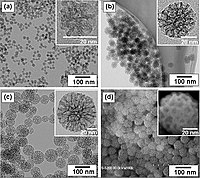
Photo from wikipedia
With the vigorous development of electronics and the increasingly prominent problem of environmental pollution, it is particularly important to exploit environmentally friendly electronic devices. Transient electronics represent a kind of… Click to show full abstract
With the vigorous development of electronics and the increasingly prominent problem of environmental pollution, it is particularly important to exploit environmentally friendly electronic devices. Transient electronics represent a kind of device that once the specified functions have completed can completely or partially disappear through physical or chemical actions. In this work, we introduce a novel guar gum-cellulose aerogel (GCA) membrane based on natural biomaterials and successfully use it as an electrolyte film to fabricate a degradable zinc-ion battery (DZIB). All components of the prepared DZIBs can be successfully degraded or disintegrate in phosphate-buffered saline (PBS) containing a solution of proteinase K after approximately 40 days. This electrolyte film has a high ionic conductivity of approximately 4.73 × 10-2 S cm-1 and a good mechanical stress property. When applied to DZIB, the production of zinc dendrites can be restrained, leading to the battery showing excellent electrochemical performance. The battery exhibits a specific capacity of 309.1 mA h g-1 at a current density of 308 mA g-1 after 100 cycles and a steady cycling ability (100% capacity retention after 200 cycles). More importantly, the electrochemical performance of DZIB is better than that of transient batteries reported in the past, taking a solid step in the field of transient electronics in the initial stage.
Journal Title: Biomaterials science
Year Published: 2022
Link to full text (if available)
Share on Social Media: Sign Up to like & get
recommendations!